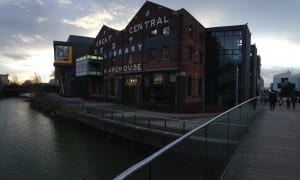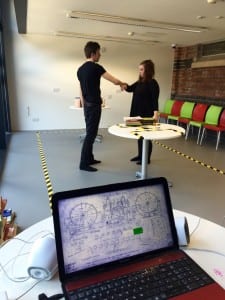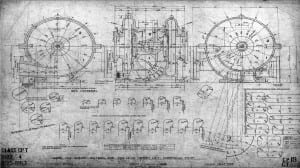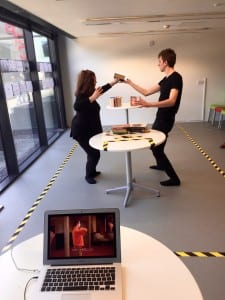The university library
“Once its stout brick walls echoed to the din of the railway goods yard, the clank of the crane and the hiss of the steam locomotive. Now the noises of a bygone industrial age have been replaced by a much more studios sound: the clicking of fingertips on computer keyboards, the riffling of pages in a book and the low murmur of voices engaged in hushed conversation…” (Weekes, 2006, 1)
The site in which I per formed is the University’s Library; architecturally, the history of this building resonates throughout this site and although the building has been extended with more contemporary structures, the original warehouse is visibly noticeable throughout and is a reminder to what this space used to be and what it has become. The masonry and the roof supports with the addition of the original machinery amidst those supports evoke the memory of what the university’s library once was; a railway goods warehouse. In its former state, the building was once an integral part of the industrial sector and could now be suggested to be a warehouse of academia, filled with books, journals and computers, tools that are used to broaden the knowledge of those who use them.
formed is the University’s Library; architecturally, the history of this building resonates throughout this site and although the building has been extended with more contemporary structures, the original warehouse is visibly noticeable throughout and is a reminder to what this space used to be and what it has become. The masonry and the roof supports with the addition of the original machinery amidst those supports evoke the memory of what the university’s library once was; a railway goods warehouse. In its former state, the building was once an integral part of the industrial sector and could now be suggested to be a warehouse of academia, filled with books, journals and computers, tools that are used to broaden the knowledge of those who use them.

Our performance was hosted in the Free Zone, which is a room built as an extension from the main building. The duration of the performance was 8 hours: this was to symbolise the shifts that the workers within the site in its former self may have worked. The performance was inspired by how the site has developed since its erection in 1861 and its original purpose being a goods and grain warehouse, to then becoming the library for the University of Lincoln. We focused on the use of movement, to evoke the mechanical nature of the library’s past; construction, to represent how the library has evolved over time and the works that are created within it; and sound, namely the sounds of the library today which have been sampled and used to create an audio track to evoke the space in both its current and former state. Our performance was primarily influenced by DV8’s interactions with objects as demonstrated in Enter Achilles. Additionally, Frantic Assemblies Building Blocks for Devising was a means of exploring movements within the space. We followed a site responsive approach for our creative process, inspired by Tristan Sharps’ creative method for Dreamthinkspeak’s performance, One Day, Maybe. This responsive approach to the architecture, the history and the atmosphere of the space that we worked within aided us in ensuring that our performance would be site-specific.
The audiences’ role was to turn on the ‘machine’ that was operating within the space via an interactive interface; they had total control over whether we moved or not as: “In contemporary visual arts practice, the work is incomplete without the viewer it addresses.” (Townsend and Thompson, 2015, 39) The performance was not just about the history of the site it was also about “the people who normally inhabit and use that place. For it wouldn’t exist without them.” (Pearson, 2010, 8) Therefore by inviting the audience to turn on the ‘machine’ means that, metaphorically, they are the people who are responsible for the creation of the book sculpture which represents all of the works created within the library.
Exploration of the Space/Initial Response
Whilst exploring each floor of the library, I became conscious to the various ways individuals occupied and interacted with the site. In Abramovic’s The Artist Is Present/Institute for Long Duration Performance Art video, (Howard Silver, 2013) Abramovic speaks about the creation of art and mentions 20th century author, Franz Kafka who said: “Remain sitting at your table and listen. Do not even listen, simply wait, be quiet, still and solitary. The world will freely offer itself to you to be unmasked, it has no choice, it will roll in ecstasy at your feet.” (Kafka, 1998, 109) I applied Kafka’s philosophy and sat in various areas of the library, for as long as up to four hours in the same space, allowing myself to open up and take in the atmosphere of the library and document it with a stream of consciousness once I decided to move areas.
From performing this exercise, I noticed that many of the people who frequent the library make use of the desktop computers, searching the web or writing in a notepad, some using IMacs, editing vast amounts of media and others reading books. This made me realise how the site has transformed from being a railway goods warehouse into a warehouse of academia. Instead of importing and exporting goods and grain, it now imports and exports academic works; what used to be stored here fed the community, what is now held in this space nourishes knowledge – the former totally tangible, the latter often intangible and abstract yet both essential to society this transformation of the site is something that I wanted to explore further. Initially, I focused on the contrast between the identity of the site in its former life being almost silent due to the fact that it is a library. However when taking audio recordings from various points in the library, it transpired that a library is not as quiet as one may think. The sound sample below shows how noisy a library can be; the sound of various library users speaking to one another, the sounds of tapping on the computer keyboard and the ongoing sounds of printers. Although the site is no longer part of the industrial sector the sounds generated within the library sound rather industrial; the ostinato of the keyboard tapping and the printers regularly in operation reminds me of a working industrial building with machinery operating within it.
Zibby Garnet Library

Whilst exploring the library we discovered a smaller space within the site named the Zibby Garnet Library. In the space we found a computer with schematics for locomotive engines on it from the Lincoln based company, Rushton Hornsby. We assume these schematics were used in the site when it was a grain and goods warehouse due to the company being based in Lincoln. As there are many digital copies of schematics available we took copies of the PDF files to print and display in the Free Zone as part of our piece, thus creating an industrial atmosphere within the performance space. By displaying those in two lines to symbolise train tracks and the fact that we intended to move up and down the room we aimed to conjure the image of a locomotive traveling, being loaded and unloaded.
DreamThinkSpeak (2013)
DreamThinkSpeak’s One Day, Maybe was performed in Gwangju and was inspired by the student protests during May 1980. Tristan Sharps states that he wants to imagine what it would have been like for those who died during the protests (in May 1980) and what if those who died were looking into 2013 and how would they feel; ‘curious’, ‘shocked.’ Also, would they ask themselves the question, ‘what did they die for’ and ‘what is democracy;’ Tristan states that only the audience can answer them. This is the direction that I would like to undertake with my performance – to have the audience ask themselves questions in reflection to what they have observed or participated in. Furthermore they will be assisted by a video that they can watch, which will give information about the history of the site and briefly show the influence other practitioners have had in our process.
Sharps does not refer to the performance as ‘site specific’ but as ‘site responsive;’ this is because the performance is inspired by the commercialised area of Gwangju and its history. However his piece is not being performed within Downtown Gwangju, the area that inspired it, it takes place in a derelict building within Gwangju. Nonetheless, the history of the site is fundamental in forming his performance and is integral to his creation. He relies on the use of the sites to create his work and to try to provoke the audience into asking themselves questions. This resonates with Lois Keidan’s theory that live art forces the question: “what is the place of this kind of work in this kind of place?” (2006, 11) In similar terms that response to the site, as performers, should inspire the audience to think about what is being presented and reflect on the relationship between the art they are viewing and the place that it is being performed in. Sharps wonders if the audience for One Day, Maybe will ask: “what did they die for” and “what is democracy.” The response to the site in performance must provoke these kind of response questions about the history of the place and its relevance in the present.
We are taking inspiration from Dreamthinkspeak’s site responsive approach in One Day, Maybe by capturing the atmosphere of the library via audio recordings then sampling the sounds to form an audio track that evokes locomotion and machinery in order to create a link to the sites past. The audio was recorded on each floor of the library at varying times of the day and then the final sample became an integral part of our performance. The sounds, accompanied with abstract mechanical/locomotive style movements and the images of the schematics of the Rushton Hornsby engines along with the video I created, would form a piece that is representative of the site in both its former and current states. By responding to the site in this manner, we are giving our audience the ability to ponder on what the university’s library once was and how is has evolved in to what it is today. Although the site is now a library, our intention is to create a performance that shows how the function of the library, in both its current and former state are somewhat similar in terms of the hard and challenging work that is undertaken within the it. However the work conducted within the library now challenges one’s mental capacity in terms of writing academia as opposed to one’s physical strength hauling bags of grain.
DV8 and Frantic Assembly
As a Library is an unconventional space to perform a movement piece, inspiration was taken from DV8’s Enter Achilles as their interaction with the space, using both the architecture and each other has an organic quality which communicates the subject of the performance in a coherent manner. Their movements based around a simple object, such as a pint glass. The playful nature of the piece is what we have taken from Enter Achilles for creating our own interactions with books and each other. The books represent the goods that were imported and exported within the warehouse and our contact improvisations moving back down the room represented the machinery having to work together when the site operated as an industrial warehouse and how people have to work together when creating work in the sites current state.
(Alexander Girshon 2008)
Whilst exploring movement and applying it to our response of the industrial history of the site for our piece, inspiration was taken from Mellina Wall’s Investing Realism in the Arts she states that dance is an “artistic language” and that “many dance movements are based on locomotion or gesture, and almost every genre of dance consists to some degree of these elements.” (2006, 92) Whilst devising, we used Wall’s statement as a foundation for creation along with Frantic Assembly’s Building Blocks For Devising. Scott Graham, the artistic director of Frantic Assembly focuses on movement within performance and how it “tells stories and helps tell stories” through “physicality and choreography.” We applied Frantic Assembly’s Round-By-Through and Hymns Hands techniques whilst interacting with books and redirecting our gaze between each other and the book: this became the foundation to movements within space whilst retaining a mechanical quality of our movement. ‘Hymns Hands’ which focuses on the movement of hands to interact with other performers, either moving their own or other performers’; this works with the ‘Round-By-Through’ technique to create movements that both travel within and directly interact with the space and each other. Graham also states that the simplicity of the ‘building blocks’ is the key element of devising because they can be applied to anything (National Theatre Discover, 2015). Having these ‘blocks’ and familiarising ourselves with them have enabled us to build a relationship with each other as performers which in turn makes the improvisation within our performance organic and allows us to follow Abramovic’s concept of being “in the moment” (Howard Silver, 2013). This in turn allows us, as performers, to be human as well as representing a machine as we still have the freedom to move intuitively feel by responding to one another’s impulses.
https://www.youtube.com/watch?v=cSHwB1vPiOQ
(Ashley Walls, 2016)
The books represent the storage of the goods within the warehouse and the moving of the books represents the loading and unloading of said goods. The schematics along the window evoke the train tracks that ran through the building to facilitate the loading and unloading process. Our sculpture of books symbolises the works created within the library and the process of creating that sculpture represents time and how the site is still expanding and new works are being created by those who use the library today.
Post-Performance

Fourteen people came into the room throughout the duration of this site-specific event to participate in and observe our piece; however, many more people noticed andspectated it by looking through the large window on the north side of the Free Room. Audience interaction was a key part of the performance as their role was essential for ‘turning on’ and ‘turning off’ the ‘machine’ by using an interface on a laptop. The overall response (from the audience) was positive as they took the time to explore the space, watch the video that narrated the history of the site and showed one of our many practical influences for the creation of the piece [shown below]. The audience were also able to follow the instructions given to them in terms of loading the ‘machine’ with books and then operating the machine using the interface meaning that the performance worked as intended. General feedback from peers who took part in the performance stated that the repetitive movements worked well as it was clear that we were performing as a machine, however it was also said that a more interactive role would have been favourable as once they had turned the ‘machine’ on, they were left to stand and observe.
https://www.youtube.com/watch?v=dIEbyC6N24M

If this piece were to be performed again, I would utilise the whole space within the Free Zone by removing the restrictions of the ‘operating area’ thus allowing us to interact with the whole space. The audience would subsequently become a part of the performance, taking a role as part of the ‘machine’ as they are an integral component to the creation of work within the site. We [the performers] would complete one task however, the objective of creating the structure can only be accomplished by the participation of our audience and their control over the piece. As Pearson states, the performance is “about the people who normally inhabit and use that place. For it wouldn’t exist without them.” (2010, 8) Like a machine, the library can only operate when all of its components work together.
The amalgamation of Pearson’s Site Specific Performance and Dreamthinkspeaks’ site responsive approach for One Day, Maybe to practitioners such as DV8 and Frantic assembly enabled me to apply styles of performance that I am familiar with to the unconventional space of the library. Pearson’s introduction to site specific performance mentions how the location of the work can act as a “mnemonic trigger, helping to evoke specific past times related to the place and time of performance and facilitating a negotiation between the meanings of those times.” (2010, 9) In the creation of a site-specific performance, it is the response to the site that creates meaning to the material produced. The response to the architecture, history and atmosphere of the university’s library, when applied to Frantic Assembly’s Building Blocks for Devising and use of a non-traditional venue as seen in Dv8’s Enter Achilles, allows the evocation of the sites past and present to materialise in an organic manner.
Word Count: 2714
Works Cited
Alexander Girshon (2008) Enter Achilles [online video] Available from https://www.youtube.com/watch?v=7c9ToyDs3mY [Accessed 6 March 2016]
Dreamthinkspeak (2013) One Day, Maybe by Dreamthinkspeak. [online video] Available from https://www.youtube.com/watch?v=yLUeQ90hu-Q [Accessed 4 March 2016]
Howard Silver (2011) Marina Abramovic: The Artist Is Present / Institute For Long Duration Performance Art [online video] Available from https://www.youtube.com/watch?v=4J75bEjp_f0 [accessed 22 March 2016]
Kafka, F. (1998) The Blue Octavo Notebooks. U.S: Exact Change.
Louisiana Channel (2013) Marina Abramovic: Advice to the Young. [online video] Available from https://www.youtube.com/watch?v=8Ck2q3YgRlY [Accessed 7 March 2016]
National Theatre Discover (2015) Frantic Assembly Master Class: Building Blocks for Devising. [online video] https://www.youtube.com/watch?v=gUqZPfGIX6U&feature=youtu.be [Accessed 8 March 2016]
Pearson, M (2010) Site Specific Performance. London: Palgrave Macmillan
Rufford, J. (2015) Theatre and Architecture. London: Palgrave Macmillan
Townsend, A. and Thomson, P. Bringing installation art to reconnaissance to share values and generate action. Educational Action Research, 23 (1) 39.
Wall, M. (2006) Investigating Realism in the Arts: Can Elements of Realism be Identified in Enter Achilles. (Lloyd Newson). Research in Dance Education.7 (1) 90-98
Weekes, A. (2006) The Great Central Warehouse University Library. Lincoln: University of Lincoln
Wiles, D. (2003) A short History of Western Performance Space. Cambridge: Cambridge University Press
Ashley Walls (2016) Exploring Round By Through and Hymns Hands. [online video] Available from https://www.youtube.com/watch?v=cSHwB1vPiOQ [Accessed 7 May 2016]